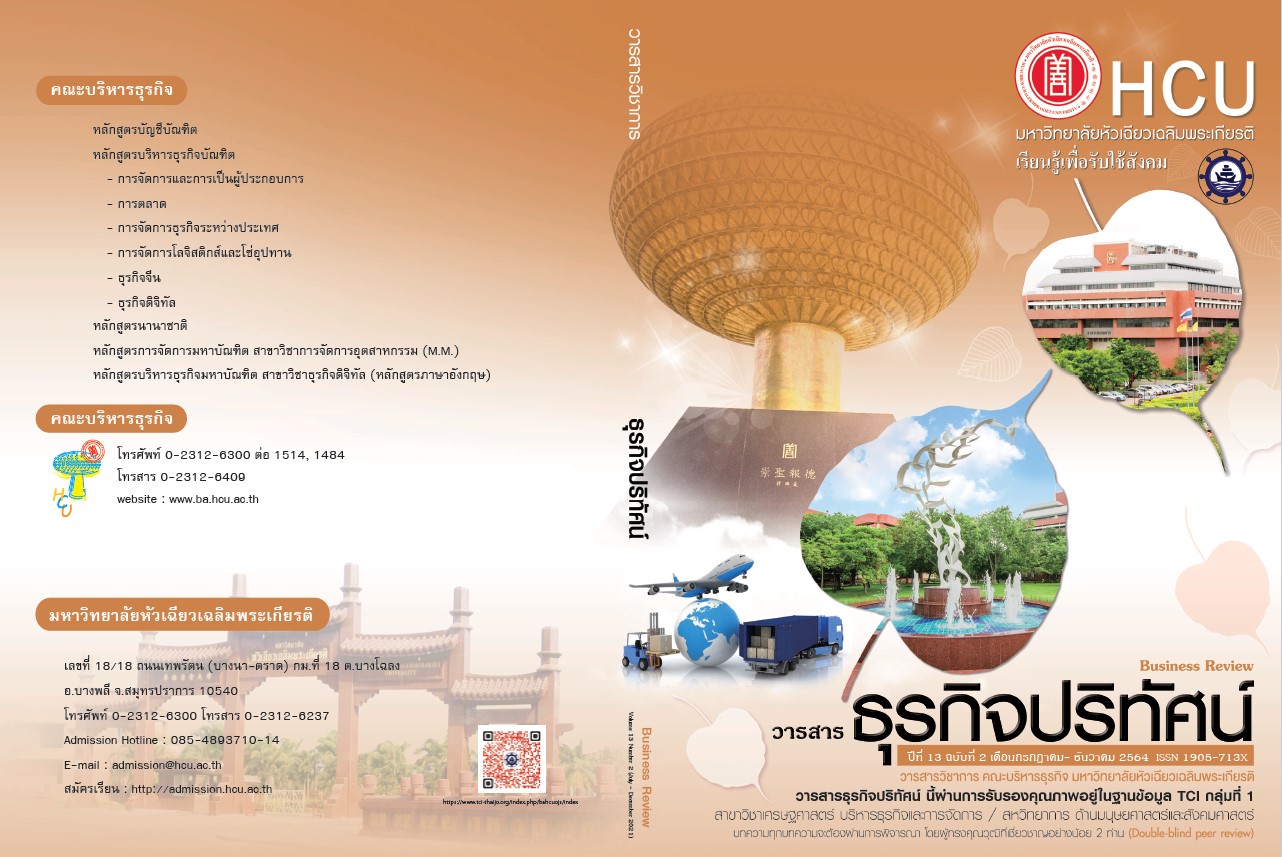เครือข่ายกวานซีของผู้ประกอบการไทย-จีน ยุคใหม่ที่มีอิทธิพลต่อความสำเร็จในธุรกิจ
คำสำคัญ:
ภูมิหลัง, เครือข่ายกวานซี, การเข้าถึงทรัพยากร, ความสำเร็จในธุรกิจบทคัดย่อ
วัตถุประสงค์ของงานเพื่อศึกษารูปแบบเครือข่ายกวานซีของผู้ประกอบการไทย จีน และเพื่อศึกษาปัจจัยเครือข่ายกวานซีที่มีอิทธิพลต่อความสำเร็จของผู้ประกอบการไทย จีนในประเทศไทย ประชากรคือ ผู้ประกอบการไทยจีนยุคใหม่ที่ประสบความสำเร็จในการทำธุรกิจประเทศไทย โดยใช้การสุ่มตัวอย่างอย่างง่าย จากนั้นใช้เครื่องมือแบบสอบถามในการเก็บข้อมูลจำนวน 150 คน สถิติที่ใช้วิเคราะห์ ได้แก่ สถิติเชิงพรรณนา และประยุกต์ใช้รูปแบบสมการโครงสร้าง (Structure Equation model: SEM) หรือการวิเคราะห์โครงสร้างความสัมพันธ์เชิงสาเหตุระหว่างตัวแปร ผลการวิจัยพบว่า ภูมิหลังที่แตกต่างกันมีอิทธิพลทางบวกต่อเครือข่ายกวานซีไม่ต่างกัน นอกจากนั้น ภูมิหลังด้านประสบการณ์ที่แตกต่างกันมีอิทธิพลทางบวกต่อการเข้าถึงทรัพยากรต่างกัน และภูมิหลังด้านอายุที่ต่างกันมีอิทธิพลทางบวกต่อความสำเร็จในธุรกิจแตกต่างกันอย่างมีนัยสำคัญทางสถิติที่ระดับ .05 ผลการวิเคราะห์รูปแบบสมการโครงสร้างของเครือข่ายกวานซีมีอิทธิพลทางตรงและทางอ้อมเชิงบวกต่อความสำเร็จในธุรกิจผ่านการเข้าถึงทรัพยากร และการเข้าถึงทรัพยากรมีอิทธิพลทางบวกต่อความสำเร็จในธุรกิจ โดยรูปแบบสามารถอธิบายความความสำเร็จในธุรกิจได้ ร้อยละ 26 (R2= 0.26)
References
กัลยา วานิชย์บัญชา. (2560). การวิเคราะห์สถิติขั้นสูงด้วย SPSS for Window (พิมพ์ครั้งที่ 12). กรุงเทพฯ: ห้างหุ้นส่วนจํากัด สามลดา.
เกริกเกียรติ พิพัฒน์เสรีธรรม. (2524). การเปลี่ยนแปลงทางสังคมเศรษฐกิจการเมืองกับการรวบอำนาจทางเศรษฐกิจโดยเอกชนในประเทศไทย. ใน การขยายตัวของระบบทุนนิยมในประเทศไทย, บรรณาธิการโดย สมภพ มานะรังสรรค์. กรุงเทพฯ: สร้างสรรค์.
แววมยุรา คำสุข, มรกต กำแพงเพชร, อาภรณ์ ภู่เผือก, ปรียา ศิวเวชช,พัฒนพงศ์ เพ็งจันทร์ และ ฉัตรแก้ว ฮาตระวัง. (2562). รูปแบบปัจจัยเชิงสาเหตุที่มีอิทธิพลต่อความจงรักภักดีของผู้บริโภคในการใช้แอปพลิเคชันอาลีเอ็กซ์เพลสของจีนในประเทศไทย. วารสารวิชาการธุรกิจปริทัศน์, 11(1), 111-126.
วิภาวี สุวิมลวรรณ. (2561) ผู้ประกอบการไทยเชื้อสายจีนในบริบทของการสร้างมโนทัศน์ความเป็นไทยระหว่างพ.ศ.2488-2500. วารสารวิชาการธุรกิจปริทัศน์, 10(1), 207-218.
Best, J. W., & Kahn, J. V. (1998). Research in education. 8th ed. Boston: Allyn and Bacon.
Cochran, W. G. (1977). Sampling techniques (3rd ed.). New York: John Wiley & Sons.
Davidsson, P., & Honig, B. (2003). The role of social and human capital among nascent entrepreneurs. Journal of Business Venturing, 18(3), 301–331.
Edelman, L., & Yli. R. H. (2010). The impact of environment and entrepreneurial perceptions on venture‐creation efforts: Bridging the discovery and creation views of entrepreneurship. Entrepreneurship: Theory and Practice, 34(5), 833–856.
Fornell, C., Johnson, M. D., Anderson, E. W., Cha, J., & Bryant, B. E. (1996). The American customer satisfaction index: nature, purpose, and findings. Journal of marketing, 60(4), 7-18.
Hair, J. F., Sarstedt, M., Ringle, C. M., & Mena, J. A. (2012). An assessment of the use of partial least squares structural equation modeling in marketing research. Journal of the academy of marketing science, 40(3), 414-433.
Hoang, H., & Antoncic, B. (2003). Network-based research in entrepreneurship: A critical review. Journal of Business Venturing, 18(2), 165–187.
Jin A. (2006). Guanxi Networks in China: Its Importance and Future Trends. China &World Economy, 14(5), 105 – 118.
Lau, V.P., Shaffer, M.A., & Au, K. (2007). Entrepreneurial career success from a Chinese perspective: Conceptualization, operationalization, and validation. Journal of International Business Studies, 38(1), 126–146.
Likert, R. E. N. S. I. S. (1972). Likert technique for attitude measurement. Social Psychology: Experimentation, Theory, Research, Sahakian, WS (Ed.). Intext Educational Publishers, Scranton, USA., ISBN-13: 9780700223879, 101-119.
Lomax, R. G., & Schumacker, R. E. (2012). A beginner's guide to structural equation modeling. New York, NY: Routledge Academic.
Lee,D.Y., and Dawes,P.L. (2005). Guanxi,Trust,and Long-term Orientation in Chinese Business Mand Arkets, Journal of International Marketing, 13 (2), 28-56.
Langenberg, E. A. (2007). Guanxi and Business Strategy: Theory and Implications for Multinational Companies in China. New York: Physica-Verlag Heidelberg.
Luo, Y., Huang, Y., & Wang, S.L. (2012). Guanxi and organizational performance: A metaanalysis. Management and Organization Review, 8(1), 139–172.
Chen, M., Chang, Yu., & Lee, C. (2015). Creative entrepreneurs' guanxi networks and success: Information and resource Journal of Business Research, 68, 900-905.
Peng, M.W., & Luo, Y. (2000). Managerial ties and firm performance in a transition economy: The nature of a micro–macro link. Academy of Management Journal, 43(3), 486–501.
Sheng, S., Zhou, K.Z., & Li, J.J. (2011). The effects of business and political ties on firm performance: Evidence from China. Journal of Marketing, 75(1), 1–15.
Downloads
เผยแพร่แล้ว
How to Cite
ฉบับ
บท
License
บทความที่ได้รับการตีพิมพ์จะเป็นลิขสิทธิ์ของวารสารธุรกิจปริทัศน์
ข้อความที่ปรากฏในบทความแต่ละเรื่องในวารสารวิชาการเล่มนี้เป็นความคิดเห็นส่วนตัวของผู้เขียนแต่ละท่านไม่เกี่ยวข้องกับมหาวิทยาลัยหัวเฉียวเฉลิมพระเกียรติ และคณาจารย์ท่านอื่น ๆ ในมหาวิทยาลัยฯ แต่อย่างใด ความรับผิดชอบองค์ประกอบทั้งหมดของบทความแต่ละเรื่องเป็นของผู้เขียนแต่ละท่าน หากมีความผิดพลาดใด ๆ ผู้เขียนแต่ละท่านจะรับผิดชอบบทความของตนเองแต่ผู้เดียว




